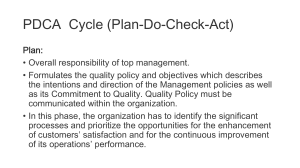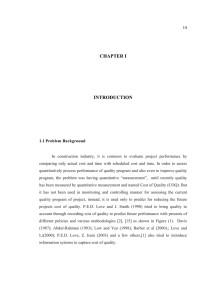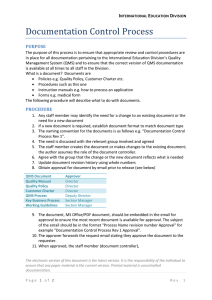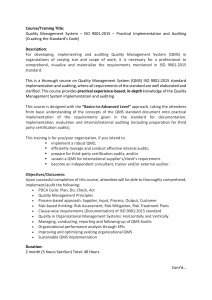EVALUATING PROCESSES WITHIN THE QUALITY MANAGEMENT SYSTEM
advertisement
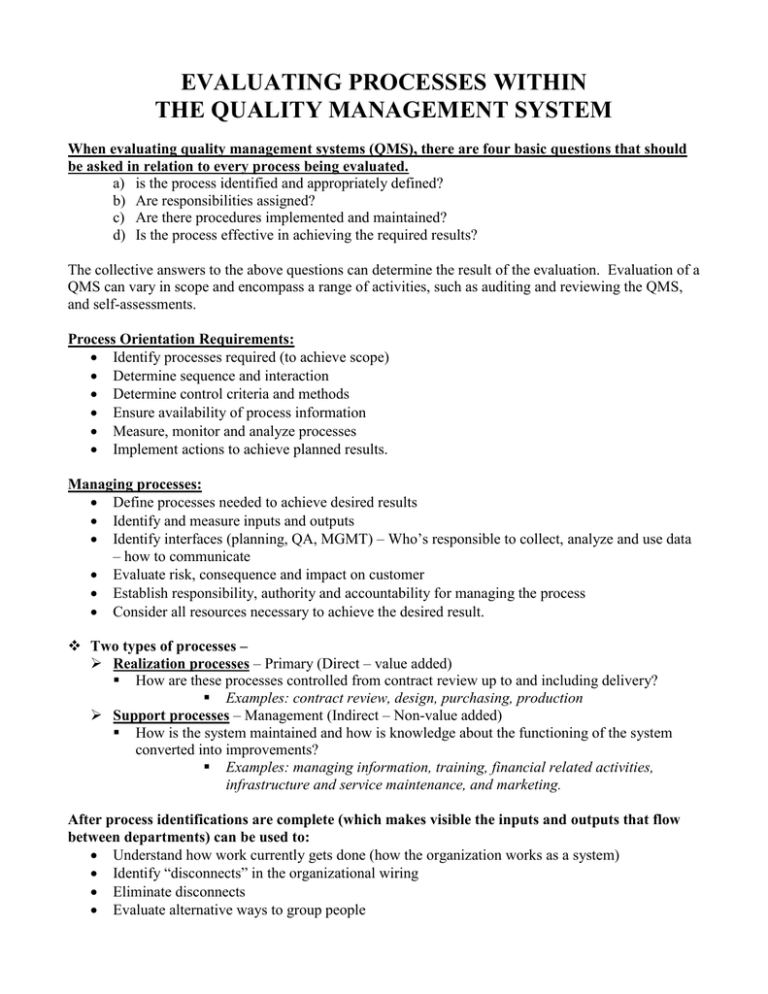
EVALUATING PROCESSES WITHIN THE QUALITY MANAGEMENT SYSTEM When evaluating quality management systems (QMS), there are four basic questions that should be asked in relation to every process being evaluated. a) is the process identified and appropriately defined? b) Are responsibilities assigned? c) Are there procedures implemented and maintained? d) Is the process effective in achieving the required results? The collective answers to the above questions can determine the result of the evaluation. Evaluation of a QMS can vary in scope and encompass a range of activities, such as auditing and reviewing the QMS, and self-assessments. Process Orientation Requirements: Identify processes required (to achieve scope) Determine sequence and interaction Determine control criteria and methods Ensure availability of process information Measure, monitor and analyze processes Implement actions to achieve planned results. Managing processes: Define processes needed to achieve desired results Identify and measure inputs and outputs Identify interfaces (planning, QA, MGMT) – Who’s responsible to collect, analyze and use data – how to communicate Evaluate risk, consequence and impact on customer Establish responsibility, authority and accountability for managing the process Consider all resources necessary to achieve the desired result. Two types of processes – Realization processes – Primary (Direct – value added) How are these processes controlled from contract review up to and including delivery? Examples: contract review, design, purchasing, production Support processes – Management (Indirect – Non-value added) How is the system maintained and how is knowledge about the functioning of the system converted into improvements? Examples: managing information, training, financial related activities, infrastructure and service maintenance, and marketing. After process identifications are complete (which makes visible the inputs and outputs that flow between departments) can be used to: Understand how work currently gets done (how the organization works as a system) Identify “disconnects” in the organizational wiring Eliminate disconnects Evaluate alternative ways to group people Cycle Time Concepts – Three levels for any process: Baseline (current run rate) process capability (what can reasonably be expected without adding resources) Theoretical (sum of value-added steps only) Key questions: What is keeping us from being closer to theoretical? What can be done to get closer? Process improvement questions: Why are we doing this? Can this step be eliminated? Can this step be combined with others? Can this step be simplified? Can this step be done in parallel with other steps? Main ingredients for improvement: Will to change – LEADERSHIP Know what to say – MANAGEMENT SYSTEMS Know how to do it – TRAINING DO IT – and improve (continuously and have a well-defined PROCESS for implementation towards success Key Process Review Details Specify process type – Realization or Support Identify Inputs – what is received in order to perform activities o Processed Material (raw materials, components, supplies, etc…) o Services (calibration, inspection, cleaning, etc…) o Hardware/equipment (major units only) o Software Controls (any system not run manually – temp controllers, timing systems, etc…) Detail Activities – what is done, step-by-step o Processed Material o Services o Hardware/equipment o Software Controls Identify Outputs – what the end product is o Processed Material o Services o Hardware/equipment o Software Controls Goals – the final result(s) for this process Objectives – of each goal Metrics – what measuring system is in place to ensure the goals are achieved Link documents (Corp Specs, CWIs, SOPs and Forms) where they are used



![[CH05] Estimasi Usaha dalam Proyek](http://s2.studylib.net/store/data/014618631_1-49924f60adc6d9c12ebc1ef87a169f34-300x300.png)
